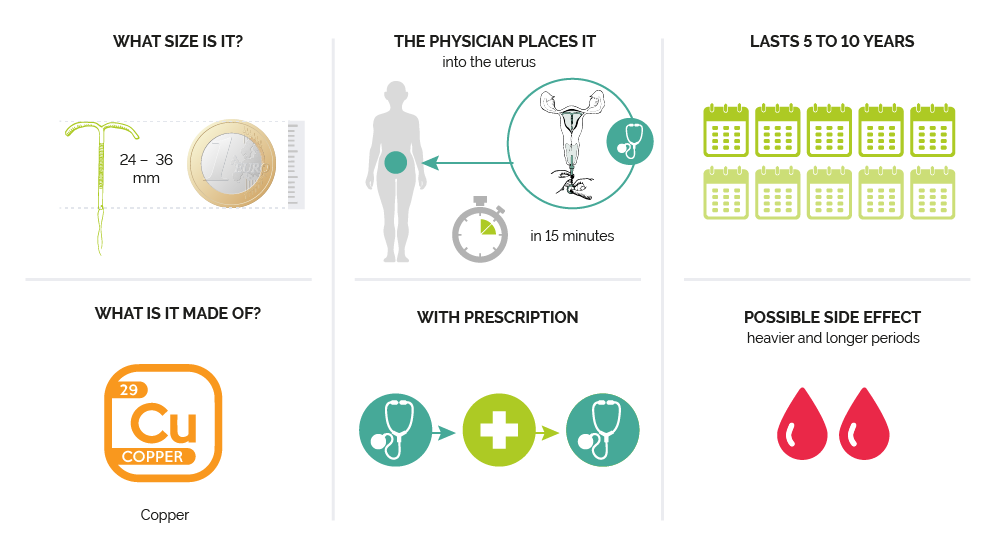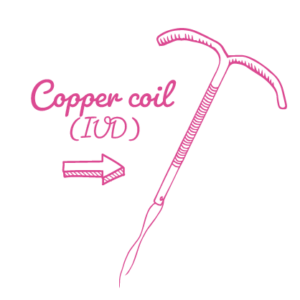The Copper IUD
The copper IntraUterine Device (IUD), is placed in the uterus by a health care professional. It does not contain hormones, but it is wrapped with a copper filament that prevents unwanted pregnancy.
*Source: effectiveness percentages are taken from WHO (2018)
HOW DOES IT WORK?
It is a small device inserted by a physician or gynecologist into the uterus.
The copper-IUD makes sperm inactive and acts on the endometrial lining, thus preventing the implementation of the potentially fertilized egg. It is effective for 5 to 10 years, depending on the model.
With this method, menstrual periods may be longer and more abundant. The copper-IUD can be inserted even if you never had children.
INTERESTING FIGURES AND DETAILS

HOW TO USE IT ?

BACKGROUND
Visit a physician or gynaecologist to receive your prescription.
STEP 1
After purchasing the copper-IUD at the pharmacy, return to your physician or gynaecologist who is familiar with the technique.
STEP 2
Premedication with painkiller is possible to minimize discomfort during the insertion of the copper-IUD. There are two thin stings hanging down which come out of the cervix. After the insertion by the gynaecologist or physician, are cut to the right length to avoid possible discomfort during sexual intercourse.
STEP 3
A ultrasound check is usually performed within 6 to 8 weeks after insertion to check that the copper-IUD is properly placed. Those two thin strings allow you to verify if the copper-IUD is still there.
WHERE TO GET IT?
Starting 1 April 2023, this contraceptive is delivered free of charge on medical prescription in any Luxembourg pharmacy to people affiliated with the National Health Fund, with no age limit.
For more information: click here.
This contraceptive can also be delivered for free at the Family Planning, including to people not covered by National Health Fund.
The copper-IUD cost on average between 100-120€* and last 5 to 10 years.
*(The price is an average indication which may vary)
Advantages
- The copper-IUDl is a very reliable method of contraception.
- It can be removed by a physician at any time if you want to become pregnant or change your contraceptive method. After removal of the copper coil, you will return to your original fertility level.
- You don’t have to think about it every day or every time you are having sex. You are protected for years.
- Ideal for women who do not want hormonal method or who are still breastfeeding.
GOOD TO KNOW
- The copper-IUD does not protect against sexually transmitted infections. Thus, remember to use condoms.
- Placing a copper-IUD is relatively quick but it can be painful.
- It does not allow you to postpone or stop your period.
- Your menstrual cycle will change. With the copper-IUD, you may have longer and heavier periods.

FREQUENTLY ASEKD QUESTIONS
Is it true that the copper IUD can replace the emergency pill?
Yes, the copper IUD can be used as emergency contraception in the same way as the emergency pill. It should be inserted within 5 days following unprotected intercourse. It is acutally more effective than the emergency pill in preventing pregnancy. Indeed, it prevents fertilisation of the ovum thanks to the spermicidal action of copper, which makes the sperm inactive. In addition, the presence of the copper IUD will reduce the chances of implantation. You can see with your gynaecologist to have it inserted as a matter of urgency.
Do I risk losing my copper IUD in the toilet?
No. But if you want to make sure it is there, insert two fingers into the vagina and look for the two threads. Do not pull on them. If you do not feel anything, consult your physician.
Is it possible to have an IUD inserted directly after giving birth?
It is not a bad idea, but the insertion of a copper IUD should not take place until 4-8 weeks after the birth. It may take up to 12 weeks after delivery for the uterus to return to its original position.
Is the copper IUD less effective than the hormonal IUS?
No. Both are similarly effective: over 99% effective. The copper IUD is 99.2% to 99.4% effective but can be kept for 5 to 10 years depending on the model. The hormonal IUS is 99.8% effective and can be kept for up to 5 years.
Does the IUD cause infertility?
The IUD does not case sterility nor infertility. In fact, this contraception is reversible, i.e. fertility returns in the months following its removal.
Can the insertion or removal of a copper IUD cause pain?
The insertion of the copper IUD into the uterus can be a little painful, similar to the pain associated with menstruation. If you strongly anticipate pain, you can discuss this with your physician. There are several ways to minimise the pain, such as taking painkillers before and after insertion, or inserting the IUD during menstruation (the cervix is more open then), etc. However, it should be noted that the vast majority of women experience only mild, bearable pain, and that this pain subsides within 24 hours. It is possible to have an IUD inserted during or outside the menstrual period.
Removal is usually painless. As the IUD is T-shaped, it folds back on itself, making it easier to remove.
Do I have period while having the IUD ?
With the copper IUD, you will continue to have periods as in a “natural” cycle. This is because the copper IUD does not contain any hormones. Some women report heavier or longer periods. In the meantime, spotting, i.e. blood loss outside of the period, may be present. If you are uncomfortable with bleeding or have questions about this contraception, do not hesitate to talk to a physician, gynaecologist or pharmacist.
If my IUD is removed, am I still protected for a few days?
No. The IUD, whether hormonal or copper, does not protect once it is removed. In fact, it is important not to have sex in the 5 days before the hormonal or copper IUD is removed. If you do, then you should keep the IUD and make an appointment for a later date. If you have had sex in the last 5 days using another method of contraception (e.g. condom), then you can have the IUD removed.
The reason? The copper IUD as well as the hormonal IUD does not prevent ovulation from occurring. At the same time, it is important to know that sperm can live for up to 5 days in the woman’s body. Thus, if ovulation, sexual intercourse and withdrawal take place within the same 5 days, this could lead to an unwanted pregnancy.
How long can you keep an IUD (intrauterine device)?
The copper IUD can be kept for 5 years. In some cases, it can be kept longer, subject to the advice of a health professional.
Please note: If you want to have your copper IUD replaced, the removal of the current IUD and the insertion of the new one must be done on the same day, otherwise the risk of pregnancy is high. If you remove your copper IUD and do not wish to become pregnant, you must immediately
take another method of contraception.
Should I check if my IUD is still there?
If you have doubts, you can always insert your fingers into your vagina and check if you can feel the 2 small threads coming out of your cervix. If you do not feel them, which does not necessarily mean that your IUD is no longer in place, you can make an appointment with your gynaecologist or physician or at the Family Planning.
Someone having a hormonal IUS or a copper IUD should normally see his/her gynaecologist at least once a year to check that everything is in order with regard to the location of the IUD. If you have any doubts, do not hesitate to make an appointment with your physician/gyneacologist.
Is it possible to have an IUD inserted even if I have no children?
Yes, if you have no contraindications (e.g. a history of ectopic pregnancy – to be discussed with your physician), you can have an IUD inserted, even if you are under 18. These possible contraindications are identified by your physician. Do not hesitate to ask your health care professional questions if needed.



